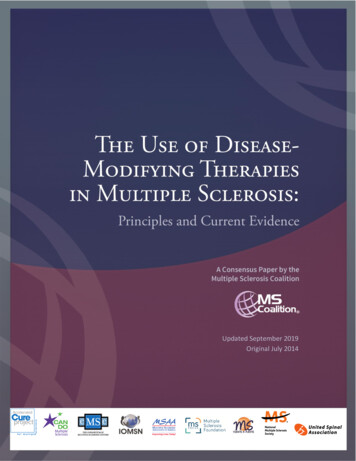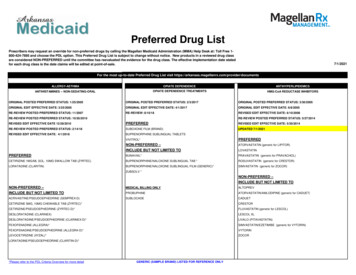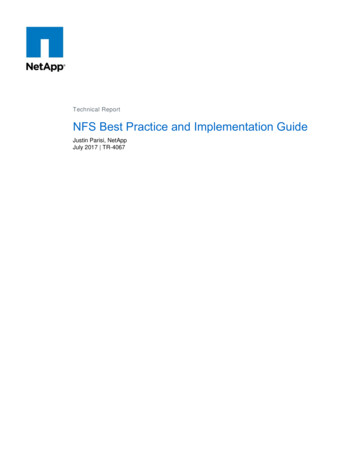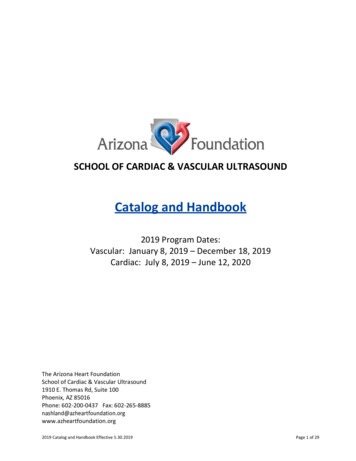
Transcription
Updated September 2019Original July 20140
DISCLOSURES2019 Revision-Writing TeamKathleen Costello, MS, ANP-BC, MSCN – Nothing to discloseRosalind Kalb, PhD – Consultant: Sanofi-Genzyme and Novartis PharmaceuticalsReviewersJack Antel, MDa – Advisory and/or data safety monitoring board: Biogen, MedDay Laboratory support throughMcGill University: Mallinckrodt, Revalesio, MedDay, Roche (Canada); Multiple Sclerosis Journal: Co-Editor for theAmericas.Brenda Banwell, MDa – Non-remunerated consultant: Biogen, Novartis Pharmaceuticals, Sanofi US; Central MRIreviewer for prior trial for Novartis; Grant Support: National Multiple Sclerosis Society, Canadian MultipleSclerosis Scientific Research Foundation.Aliza Ben-Zacharia, DrNP, ANP, MSCNa – Consultant: Biogen, EMD Serono, Novartis Pharmaceuticals, Genentech,Genzyme Corporation; Grant support: Biogen, Novartis Pharmaceuticals.James Bowen, MDa – Consultant: Biogen IDEC, Celgene, EMD Serono, Genentech, Novartis; Speaker: Biogen IDEC,EMD Serono, Genentech, Novartis; Grant support: Abbvie, Alkermes, Biogen IDEC, Celgene, Genzyme, Genentech,Novartis, TG Therapeutics; Shareholder: Amgen.Bruce Cohen, MDa – Consultant: Biogen-Idec, EMD Serono, Celgene; Funded Institutional Research throughNorthwestern University, Novartis Pharmaceuticals, Genentech / Hoffman La Roche, MedDay.Bruce Cree, MD, PhDb – Consultant: Abbvie, Biogen, EMD Serono, Genzyme Corporation, Aventis, MedImmune,Novartis Pharmaceuticals, Teva Pharmaceuticals; Grant/research support (including clinical trials): AcordaTherapeutics, Avanir Pharmaceuticals, Biogen, EMD Serono, Hoffman La Roche, Novartis Pharmaceuticals.Suhayl Dhib-Jalbut, MDa – Grant support: Teva Pharmaceuticals, Biogen, Bayer.David E. Jones, MDc – Past consultant: Biogen, Genzyme Corporation, Novartis Pharmaceuticals; Past grantsupport: National Multiple Sclerosis Society, Biogen.Daniel Kantor, MDd – Consultant: Actelion Pharmaceuticals, Avanir Pharmaceuticals, Biogen, CelgeneCorporation, Genzyme Corporation, Mylan, Novartis Pharmaceuticals, Osmotica Pharmaceutical; Speaker: AvanirPharmaceuticals, Biogen, Genzyme Corporation, Novartis Pharmaceuticals; Grant support: ActelionPharmaceuticals, Biogen, Genzyme Corporation, Novartis Pharmaceuticals.Flavia Nelson, MDb – Consultant for Advisory Boards or Speaker: Biogen, Novartis Pharmaceuticals, TevaPharmaceuticals, Bayer HealthCare, Mallinckrodt, Genzyme Corporation; Grant support: National Institutes ofHealth.Nancy Sicotte, MDe – Grant support: National Multiple Sclerosis Society, Guthy-Jackson Charitable Foundation,Race to Erase MS, Patient-Centered Outcomes Research Institute (PCORI).aReviewedoriginal, March 2015, July 2016, March 2017, September 2018, June 2019 updatesoriginal onlycReviewed March 2015, July 2016, March 2017 updatesdReviewed original, March 2015, July 2016, September 2018, June 2019 updateseReviewed original, March 2015, July 2016, March 2017, September 2018 updatesbReviewedOriginal Writing and Development TeamKathleen Costello, MS, ANP-BC, MSCN – Nothing to discloseJune Halper, MSN, APN-C, MSCN, FAAN – Nothing to discloseRosalind Kalb, PhD – Consultant: Sanofi-GenzymeLisa Skutnik, PT, MA, MA – Consultant: Biogen, Sanofi-GenzymeRobert Rapp, MPA* – Nothing to disclose*deceased1
THE USE OF DISEASE-MODIFYING THERAPIES IN MULTIPLE SCLEROSISPrinciples and Current EvidenceA Consensus Paper by the Multiple Sclerosis CoalitionABSTRACTPurpose: The purpose of this paper, which was developed by the member organizations of the Multiple SclerosisCoalition*, is to summarize current evidence about disease modification in multiple sclerosis (MS) and providesupport for broad and sustained access to MS disease-modifying therapies for people with MS in the UnitedStates.Development Process: The original writing and development team comprised of professional staff representingthe Coalition organizations (Rosalind Kalb, Kathleen Costello, June Halper, Lisa Skutnik and Robert Rapp)developed a draft for review and input by nine external reviewers (Brenda Banwell, Aliza Ben-Zacharia, JamesBowen, Bruce Cohen, Bruce Cree, Suhayl Dhib-Jalbut, Daniel Kantor, Flavia Nelson and Nancy Sicotte). Thereviewers, selected for their experience and expertise in MS clinical care and research, were charged withensuring the accuracy, completeness and fair balance of the content. The revised paper was then submitted forreview by the medical advisors of the Coalition member organizations.The final paper, incorporating feedback from these advisors, was endorsed by all Coalition members, andsubsequently by Americas Committee for Treatment and Research in Multiple Sclerosis (ACTRIMS), andpublished in November 2014.Updates with Reviews by External Reviewers and ACTRIMS for their Endorsement:March 2015July 2016March 2017September 2018June 2019Conclusions: Based on a comprehensive review of the current evidence, the Multiple Sclerosis Coalition* statesthe following:Treatment Considerations: Initiation of treatment with an FDA-approved disease-modifying therapy is recommended:- As soon as possible following a diagnosis of relapsing multiple sclerosis, regardless of the person's age.Relapsing MS includes: clinically isolated syndrome (CIS): People with a first clinical event and MRI features consistent withMS in whom other possible causes have been excluded relapsing-remitting MS active secondary progressive MS with clinical relapses or inflammatory activity on MRI.- For individuals with primary progressive multiple sclerosis, with an agent approved for this phenotype Clinicians should consider prescribing a high efficacy medication such as alemtuzumab, cladribine,fingolimod, natalizumab or ocrelizumab for newly diagnosed individuals with highly active MS. Clinicians should also consider prescribing a high efficacy medication for individuals who have breakthroughactivity on another disease-modifying therapy, regardless of the number of previously used agents.* The Multiple Sclerosis Coalition was founded in 2005 to increase opportunities for cooperation and providegreater opportunity to leverage the effective use of resources for the benefit of the MS community. Memberorganizations include Accelerated Cure, Can Do Multiple Sclerosis, Consortium of Multiple Sclerosis Centers,International Organization of Multiple Sclerosis Nurses, Multiple Sclerosis Association of America, MultipleSclerosis Foundation, National Multiple Sclerosis Society and United Spinal Association. MS Views and Newsserves as an affiliate member (since 2015).2
Treatment with a given disease-modifying medication should be continued indefinitely unless any of thefollowing occur – in which case an alternative disease-modifying therapy should be considered:- Sub-optimal treatment response as determined by the individual and his or her treating clinician- Intolerable side effects, including significant laboratory abnormalities- Inadequate adherence to the treatment regimen- Availability of a more appropriate treatment option- The healthcare provider and patient determine that the benefits no longer outweigh the risksMovement from one disease-modifying therapy to another should occur only for medically appropriatereasons as determined by the treating clinician and patient.When evidence of additional clinical or MRI activity while on consistent treatment suggests a sub-optimalresponse, an alternative regimen (e.g., different mechanism of action) should be considered to optimizetherapeutic benefit.The factors affecting choice of therapy at any point in the disease course are complex and most appropriatelyanalyzed and addressed through a shared decision-making process between the individual and his or hertreating clinician. Neither an arbitrary restriction of choice nor a mandatory escalation therapy approach issupported by data.Access Considerations: Due to significant variability in the MS population, people with MS and their treating clinicians require accessto the full range of treatment options for several reasons:- MS clinical phenotypes may respond differently to different disease-modifying therapies.- Different mechanisms of action allow for treatment change in the event of a sub-optimal response.- Potential contraindications limit options for some individuals.- Risk tolerance varies among people with MS and their treating clinicians.- Route of delivery, frequency of dosing and side effects may affect adherence and quality of life.- Individual differences related to tolerability and adherence may necessitate access to differentmedications within the same class.- Pregnancy and breastfeeding limit the available options. Individuals’ access to treatment should not be limited by their frequency of relapses, level of disability, orpersonal characteristics such as age, sex or ethnicity. Absence of relapses while on treatment is a characteristic of treatment effectiveness and should not beconsidered a justification for discontinuation of treatment. Treatment should not be withheld during determination of coverage by payers as this puts the patient at riskfor recurrent disease activity.3
ContentsABSTRACT . 2INTRODUCTION . 5Epidemiology, Demographics, Disease Course . 5Inflammation and CNS Damage . 6OVERVIEW OF FDA-APPROVED DISEASE-MODIFYING AGENTS IN MS . 8DISEASE-MODIFYING THERAPY CONSIDERATIONS . 14Disease Factors Highlighting the Importance of Early Treatment . 14Evidence Demonstrating the Impact of Treatment Following a First Clinical Event . 17Evidence Demonstrating the Impact of Treatment on Relapsing MS . 17Head-to-head comparison data in relapsing MS . 26Evidence Demonstrating the Impact of Treatment on Progressive MS . 27Evidence Supporting the Need for Treatment to be Ongoing. 29Use of Disease-Modifying Therapies in Pediatric MS . 30Treatment Considerations in Women and Men in Their Reproductive Years . 31Rationale for Access to the Full Range of Treatment Options . 33CONCLUSIONS REGARDING THE NEEDS OF PEOPLE WITH MS . 39Treatment Considerations . 39Access Considerations. 39REFERENCES . 40APPENDICES . 0APPENDIX A: Multiple Sclerosis Disease Courses 2013 Revisions 1 . 0Appendix B: 2017 McDonald Criteria for the Diagnosis of Multiple Sclerosis . 4APPENDIX C: Treatments Used Off-Label for Multiple Sclerosis . 70THE MULTIPLE SCLEROSIS COALITION . 794
INTRODUCTIONMultiple sclerosis (MS) is a disorder of the central nervous system (CNS) characterized by inflammation,demyelination and degenerative changes. Most people with MS experience relapses and remissions ofneurological symptoms, particularly early in the disease, and clinical events are usually associated with areas ofCNS inflammation.1-4 Gradual worsening or progression, with or without subsequent acute attacks ofinflammation or radiological activity, may be present very early, but usually becomes more prominent over time.5While traditionally viewed as a disease solely of CNS white matter, more advanced imaging techniques havedemonstrated significant early and ongoing CNS gray matter damage as well.6-9Those diagnosed with MS may have many fluctuating and disabling symptoms (including, but not limited to,fatigue, impaired mobility, mood and cognitive changes, pain and other sensory problems, visual disturbances andelimination dysfunction), resulting in a significant impact on quality of life for patients and their families. As themost common non-traumatic, disabling neurologic disorder of young adults – a group not typically faced with achronic disease – MS threatens personal autonomy, independence, dignity and life planning,10 potentially limitingthe achievement of life goals. The free-spirited spontaneity so highly valued by young adults needs to shift topurposeful planning, taking into account the challenges posed by fluctuations in function and an uncertain future.The patient’s self-definition, roles and relationships may be co-opted by the need to adapt to an unpredictabledisease requiring frequent healthcare visits, periodic testing and costly medications.Compared to patients with other chronic diseases, those diagnosed with MS have diminished ratings in health,vitality and physical functions, and experience limitations in social roles 11 Productivity and participation areaffected for many, including early departure from the workforce and inability to fulfill householdresponsibilities.12 In a study of disease burden, based on data from the Medical Expenditure Panel Survey (MEPS)– a public access, large-scale database that links direct cost information with information on productivity andhealth-related quality of life – Campbell and colleagues found that annual direct healthcare costs for people withMS were 24,327 higher than for the general population. In addition, people with MS had a significantly higherrisk of being unemployed, spent significantly more time in bed, and lost on average 10.04 quality-adjusted lifeyears compared to the general population. In a systematic review of 48 cost-of-illness studies, medications werethe main expense for those with milder disease while loss of income combined with informal care needscontributed the biggest costs for those with more advanced disease.13,14 Furthermore, registry studies specific toMS and large population cohort studies of individuals untreated with a disease-modifying therapy havedemonstrated a reduced life expectancy of 8-12 years.15Epidemiology, Demographics, Disease CourseIt is estimated that there are more than two million people with MS worldwide 16 with the number approaching1,000,000 in the United States.17 Women are affected at least three times more than men18 and Caucasians areaffected more than other racial groups.19 However, a recent study20 suggested that African-American women havea higher than previously reported risk of developing MS and several studies have suggested that AfricanAmericans21–25 and Hispanics26–30 may have a more active, rapidly progressive disease course. MS is typicallydiagnosed in early adulthood, but the age range for disease onset is wide with both pediatric cases and new onsetin older adults. Historically, a geographic gradient has been observed with a higher incidence of MS withincreased distance from the equator.31,32 However, some recent studies have not demonstrated the samelatitudinal gradient,33,34 suggesting either a change in regional risk determinants for MS or a broadening of theprevalence and recognition of MS worldwide.The course of MS varies. However, 85-90 percent of individuals demonstrate a relapsing pattern at onset, whichtransitions over time in most untreated patients to a pattern of progressive worsening with few or no relapses orMRI activity (secondary progressive MS). Approximately 10-15 percent present with a relatively steadyprogression of symptoms over time (primary progressive MS), of which some will subsequently experienceinflammatory activity by clinical or MRI criteria.1,2 This primary progressive course is generally diagnosed at anolder age, is typically spinal cord-predominant, and is distributed more equally in men and women. The 2013revisions to the MS clinical course descriptions1 further characterize relapsing and progressive MS as active (newrelapses and/or new MRI activity) or not active, and worsening (disability progression) or stable based on clinicaland MRI criteria. (See Appendix A for a full description of the revised disease courses).5
Prior to the era of disease modifying treatments, approximately half of patients diagnosed with relapsing MSwould progress to secondary progressive MS by 10 years, and 80-90 percent would do so by 25 years.35–37Approximately half of patients would no longer be able to walk unaided by 15 years. 36 More recent data in the eraof disease-modifying therapy demonstrate that the percentage of patients with relapsing MS who developsecondary-progressive MS may now be 15-30 percent.38Inflammation and CNS DamageAt present, much of the CNS damage in MS is believed to result from an immune-mediated process. Although thecause of the immunological changes is not completely understood, Vitamin-D deficiency, which is commonlypresent in MS, is thought to enhance inflammation. Gut dysbiosis is also thought to contribute to MS pathogenesisthrough mechanisms that have yet to be defined.39This immune-mediated process includes components of the innate immune system (including macrophages,natural killer cells and others) as well as adaptive immune system activation of certain lymphocyte populations inperipheral lymphoid organs.40 CD4 lymphocytes, CD8 lymphocytes and B lymphocytes are activated in theperipheral lymph tissues. Antigen presentation to naïve CD4 lymphocytes causes differentiation into various Tlymphocyte cell populations, depending on the antigen presented, the cytokine environment and the presence ofco-stimulatory molecules. The T lymphocyte cell populations include Th1 and Th17 lymphocytes (which areassociated with a variety of inflammatory cytokines that activate macrophages and opsonizing antibodies) andTh2 lymphocytes and T regulatory cells (which drive humoral immunity or secrete anti-inflammatorycytokines).40–42 In people with MS, there is a bias towards a Th1 and Th17 environment with T regulatorydysfunction that allows inflammation to predominate.43 Secreted cytokines and matrix metalloproteinasesdisrupt the blood-brain barrier.44 This disruption, along with up-regulation of adhesion molecules on blood vesselendothelium and activation of T cells, allows T cells to gain entry into the CNS, where additional activation takesplace that initiates a damaging inflammatory cascade of events within the CNS. Multiple inflammatory cellsbecome involved, including microglial cells and macrophages. In addition to CD4 activation, CD8 T lymphocyteshave also been identified as important contributors to damaging CNS inflammation, and in fact have beenidentified by numerous researchers as the predominant T cell present in active MS lesions. 45 Mechanisms ofremission and recovery are not fully understood but are believed to be mediated by the expansion of regulatorycells that downregulate inflammation such as Foxp3 positive cells, Tr1 (IL-10 secreting), Th3 (TGF-B secreting)and CD56bright NK cells. Proliferation of progenitor oligodendroglia and remyelination contribute to recovery atleast in the early stages of the disease.46Further contributions to CNS damage in MS are associated with B cell activation. B cells function as antigenpresenting cells and also produce antibodies and pro-inflammatory cytokines that have damaging effects onmyelin, oligodendrocytes and other neuronal structures.47 The importance of B cells in MS immunopathogenesisis supported by the consistent finding of oligoclonal immunoglobulins in the CSF; the successful clinical trials withB cell depleting monoclonal antibodies (rituximab and more recently ocrelizumab) that showed efficacy in RRMSand a subset of patients with primary progressive disease; and the presence of B-cell enriched meningeal folliclesin progressive patients.48Recent studies have also revealed that mitochondrial damage, possibly as a result of free radical, reactive oxygenspecies and nitrous oxide (NO) activity associated with activated microglia, and iron deposition occur in MS, andmake a significant contribution to demyelination and oligodendrocyte damage.49–51Immune-mediated responses leading to inflammation, with secretion of inflammatory cytokines, activation ofmicroglia, T and B cell activity, mitochondrial damage and inadequate regulatory function, are believed to be atleast partially responsible for demyelination, oligodendrocyte loss and axonal damage – all of which occur inacute inflammatory lesions.51,52 Axons that survive acute attacks may require increased energy to compensate fordamage leading to later death from metabolic stress. 51 Axonal loss, which correlates best with disability, beginsearly in the disease process as evidenced by identified pathological changes as well as imaging studies.52,536
Figure 1: Inflammatory cascade in multiple sclerosisInflammatory Cascade in Multiple SclerosisPeriphery1.CNSAntigen presentation to CD4 prompting activation andproliferation of pro-inflammatorylymphocytes (Th1 and Th17)8. Presentation of CNS antigen toT cell with reactivation9. Recruitment of otherinflammatory cells:CD8 B cellsmonocytesmacrophagesmicroglia2.Secretion of pro-inflammatorycytokines3.Up-regulation of adhesionmolecules4.T cell migration across the bloodbrain barrier into the CNS5.B cell activation, proliferation andmigration into the CNS6.Migration of monocytes andmacrophages into the CNS7.Inadequate T regulatory function10. Damage to myelin,oligodendrocytes and axonsresulting from:cytokine damageantibody activitycomplement damageoxidative stressmitochondrial dysfunctionBlood Brain Barrier7
OVERVIEW OF FDA-APPROVED DISEASE-MODIFYING AGENTS IN MSCurrently, 17 disease-modifying agents are approved by the U.S. Food and Drug Administration (FDA).Note: Zinbryta (daclizumab) was approved to treat relapsing forms of MS in 2016 and voluntarily withdrawnfrom the market in 2018.Table 1: FDA-approved disease-modifying agents in MS (in alphabetical order by route of administration).Refer to the full FDA prescribing information for each medication for contraindications and additional details about side effects,warnings and precautions, and pre-treatment recommendations and procedures.FDA pregnancy categories were replaced by pregnancy guidelines in June 2015 to make them more meaningful for patients andproviders, and to allow for patient-specific counseling and informed decision-making (see p. 32).Agent - Self-InjectedProposed MoASide EffectsWarnings/Precautionsglatiramer acetate54,55(Copaxone ;Glatopa - therapeutic equivalent;Glatiramer acetate injection)Mechanism of action in MS is not fullyunderstood. Subsequent researchsuggests:-Promotes differentiation in Th2 andT-reg cells leading to bystandersuppression in CNS56-Increases release of neurotrophicfactors from immune cells56-Deletion of myelin-reactive T cells56-Injection-site reactions-Lipoatrophy-Vasodilation, rash,dyspnea-Chest pain-Lymphadenopathy54-Immediate transient post-injectionreaction (flushing, chest pain,palpitations, anxiety, dyspnea, throatconstriction, and/or urticaria)-Lipoatrophy and skin necrosis-Potential effects on immuneresponseMechanism of action in MS isunknown. Subsequent researchsuggests:-Promotes shift from Th1-Th2-Reduces trafficking across BBB58,59-Restores T-reg cells56-Inhibits antigen presentation56-Enhances apoptosis ofautoreactive T-cells56-Flu-like symptoms-Depression-Elevated hepatictransaminases-Depression, suicide and/orpsychosis-Hepatic injury-Anaphylaxis and other allergicreactions-CHF-Lower peripheral blood counts-Seizures-Other autoimmune disorders-Thrombotic microangiopathySame as above-Injection-site reactions-Flu-like symptoms-Abdominal pain-Depression-Elevated ession and/or suicide-Hepatic injury-Anaphylaxis and other allergicreactions-Injection-site reactions includingnecrosis-Lower peripheral blood counts-Seizures-Thrombotic microangiopathySame as above-Flu-like symptoms-Injection-site reactions-Elevated hepatictransaminases-Low WBC-See warnings61,62-Hepatic injury-Anaphylaxis and other allergicreactions-Depression and/or suicide-CHF-Injection-site necrosis-Low WBC-Flu-like symptoms-Seizures-Thrombotic microangiopathy20mg SC daily or 40mg SC threetimes weeklyIndication: for the treatment of adultswith relapsing forms of MS, to includeclinically isolated syndrome, relapsingremitting disease, active secondaryprogressive diseaseinterferon beta-1a57(Avonex )30mcg IM weeklyIndication: or the treatment of adultswith relapsing forms of MS, to includeclinically isolated syndrome, relapsingremitting disease, active secondaryprogressive diseaseinterferon beta-1a60(Rebif )22mcg or 44mcg SC three timesweeklyIndication: for the treatment of adultswith relapsing forms of MS, to includeclinically isolated syndrome, relapsingremitting disease, active secondaryprogressive diseaseinterferon beta-1b61,62(Betaseron ) (Extavia )0.25mg SC every other dayIndication: for the treatment ofadults with relapsing forms of MS, toinclude clinically isolated syndrome,relapsing-remitting disease, activesecondary progressive disease8
Agent - Self-InjectedProposed MoASide EffectsWarnings/Precautionspeginterferon beta-1a63–65(Plegridy )Same as above-Flu-like symptoms-Injection-site reactions-Elevated hepatictransaminases-Low WBC-See warnings63-Depression and/or suicide-Hepatic injury-Anaphylaxis and other allergicreactions-CHF-Low peripheral blood counts-Seizures-Other autoimmune disorders-Thrombotic microangiopathyProposed MoASide EffectsWarnings/PrecautionsMechanism has not been fully elucidatedbut is thought to involve cytotoxic effectson B and T lymphocytes throughimpairment of DNA synthesis resulting indepletion of lymphocytes.- Upper respiratory tractinfection- Headache- Lymphopenia- Nausea- Back pain- Arthralgia and arthritis- Insomnia- Bronchitis- Hypertension- Fever- Depression- Malignancies- Risk of teratogenicity- Lymphopenia- Infections (mostly frequent: herpeszoster, pyelonephritis)- Hematologic toxicity- Graft-vs-host disease with bloodtransfusion; irradiation of cellularblood products prior toadministration is recommended inthe event of transfusion- Liver injury- Hypersensitivity- Cardiac failure- Screen for: hepatitis B and C,varicella zoster virus (VZV),tuberculosis, HIV- Baseline (within 3 months) MRIbefore initiating first treatmentcourse; at first sign or symptom ofprogressive multifocalleukoencephalopathy(PML), withhold medication- Administer all immunizationsaccording to immunizationguidelines prior to startingtreatment; administer liveattenuated or live vaccines at least 46 weeks prior to starting treatment;avoid live-attenuated or live vaccinesduring or after treatment until whiteblood cell counts are within normallimits125mcg SC every two weeksIndication: for the treatment ofadults with relapsing forms of MS, toinclude clinically isolated syndrome,relapsing-remitting disease, activesecondary progressive diseaseAgent – Oralcladribine 66,67(Mavenclad )Recommended cumulative dosage- 3.5 mg/kg body weightadministered orally and dividedinto 2 yearly treatment courses(1.75 mg/kg per treatmentcourse); each treatment coursedivided into 2 treatment cyclesseparated by 23-27 days (see PI)Indication: relapsing forms of MS,including relapsing-remitting andactive secondary progressivedisease. Use is generallyrecommended for patients whohave had an inadequate responseto, or are unable to tolerate, analternate drug. Use is notrecommended for patients withCIS because of its safety profile.Boxed WarningMalignancies and risk ofteratogenicitydimethyl fumarate68(Tecfidera )240mg PO twice dailyIndication: for the treatment ofadults with relapsing forms of MS, toinclude clinically isolated syndrome,relapsing-remitting disease, activesecondary progressive diseaseMechanism of action in MS isunknown. It has been shown topromote anti-inflammatory andcytoprotective activities mediated byNrf2 pathway.599-Anaphylaxis andangioedema-PML-Lymphopenia-Elevated AST-Liver injury-Flushing-GI symptoms-Pruritis-Rash65-Anaphylaxis and angioedema-PML-Lymphopenia (considerdiscontinuing treatment in patientswith persistent lymphopenia ( 500)lasting over 6 months)-Flushing-Liver injury
Agent – OralProposed MoASide EffectsWarnings/Precautionsfingolimod69(Gilenya )Mechanism of action in MS most likelyinvolves blocking of S1P receptor onlymphocytes thus preventing theiregress from secondary lymphorgans.69- Headache- Influenza- Diarrhea- Back pain- Elevated hepaticenzymes- Cough- Bradycardia followingfirst dose- Macular edema- Lymphopenia- Bronchitis/pneumonia- Bradyarrhythmia and/oratrioventricular block following firstdose- Risk of infections including serious
Purpose: The purpose of this paper, which was developed by the member organizations of the Multiple Sclerosis Coalition*, is to summarize current evidence about disease modification in multiple sclerosis (MS) and provide support for broad and sustained access to MS disease-modifying therapies










